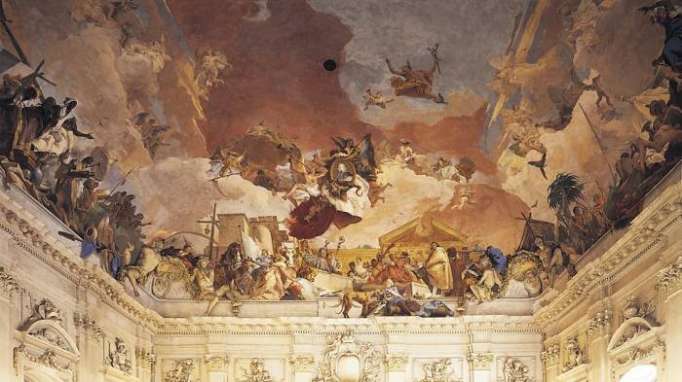Las Meninas - Velázquez

A painting that stakes the most ambitious claim for the power of art and the artist.Wikimedia
"Anyone who comes into the presence of this masterpiece, who steps across the threshold of that huge work, feels him or herself uncannily in the presence of all the characters who populate it.
"It is full of games that play with the mind, full of complicated layers of meaning all of which build into a meditation on what it is to paint.
"And they are so fiendishly ingenious that they challenge generation after generation of writers, and commentators and artists, to nail its ultimate meaning and... I don’t think anyone has yet quite got to the bottom of it."
The Night Watch - Rembrandt
The actual title of The Night Watch, as it became known at the end of the 18th century, is The Company of Captain Frans Banning Cocq and Lieutenant Willem van Ruytenburch Preparing to March Out. Rembrandt was commissioned to paint a group portrait of a company of civic guardsmen; these works, peculiar to Amsterdam, were designed to hang in the assembly halls of such organisations to promote a sense of civic duty and pride.
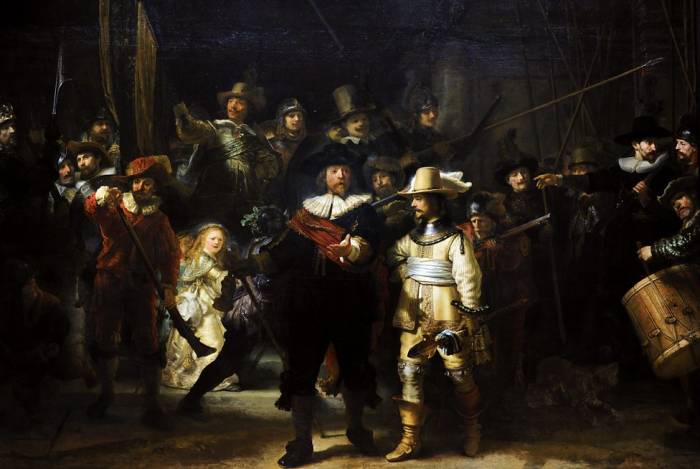
The Netherlands, 1642 | Getty Images
"The idea of this painting is above all energy, dynamism, vitality, that’s what Rembrandt wanted to celebrate in Amsterdam. It is propulsive, it moves through that frame into our own space. Rembrandt has used his entire box of tricks to make this feel like a moving image, like a movie in fact. It also has a soundtrack. Everything is exploding, a gun is being fired, a drum is being beaten, a dog is barking.
"Some people have trouble with this painting and have thought of it for centuries as a kind of garish chaos - too much going on. But, Rembrandt being Rembrandt, he stops just this side of chaos....The Night Watch is a perfect miracle of dynamism and discipline together. That’s the real idea that Rembrandt is trying to communicate. The idea of Holland's vrijheid: Dutch liberty."
"The fact that it’s a painting about freedom with order makes it an extraordinary moment. Not just in the history of painting - it’s a moment in the history of civilisation too. Amsterdam is beating not only the drum but its own chest, saying we can be free but we are also strong and disciplined. This is the visual declaration of republican liberty."
The ceiling of the Würzburg Residence - Tiepolo
In 1752, Prince-Bishop Carl Phillip von Greiffenclau invited Venetian painter Giovanni Battista Tiepolo to fresco the ceiling of the stairwell of the recently built palace of the Prince-Bishops in Würzburg, Bavaria. The composition of the fresco, Apollo and the Continents, takes into account the many viewpoints available to the visitor, who changes direction several times during his climb up the stairs. The Würzburg frescoes are considered the high point of Tiepolo's artistic career.
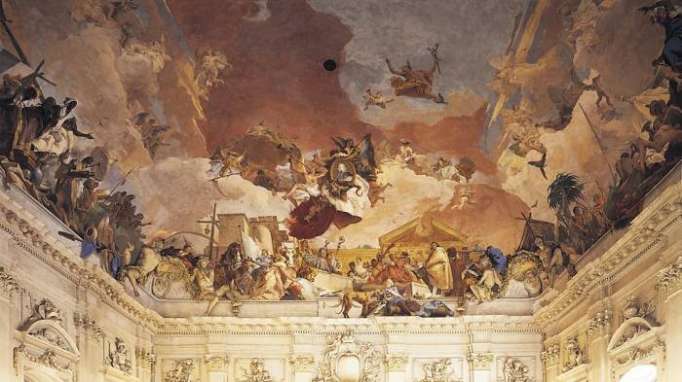
Germany, 1752-3 | Getty Images
"The work of the 18th century Venetian painter, Giambattista Tiepolo , this fresco (the largest in the world) on the ceiling of the Würzburg Residence in Bavaria is a vision of Apollo the Sun God illuminating the four continents of the world.
"It’s a classic Baroque subject - the entire world in one image. But in it, Tiepolo uses the Venetian embrace of colour and movement to create something revolutionary. Tiepolo really re-invents what it is to look at a painting, what a painting is... you can walk around this space and it is a world in motion. It’s almost as though he anticipates movie directors in his insistence that everything floats, everything is elastic.
"And there is a second reason this is one of the greatest things ever fashioned by the hand of man... this is meaty, earthy, sweaty humanity. I don’t think there’s any other work in all of European art where we see so many backs - backs of bodies, backs of head - everyone is oblivious almost to our presence. They are just getting on with what they have to do. And you put those two qualities together of Tiepolo – his astonishing exhilarating freedom and his instinct for the earthiness of human life translated into painting – and you know you have something that’s radically fresh.
"Tiepolo has delivered an anthem not to faith or power, but to the world of work and human creativity in all its sensual/richly-coloured glory."
The Madonna of Loreto - Caravaggio
Housed in the Church of San Agostino in Rome, Simon Schama says The Madonna of Loreto "may be my favourite Caravaggio".
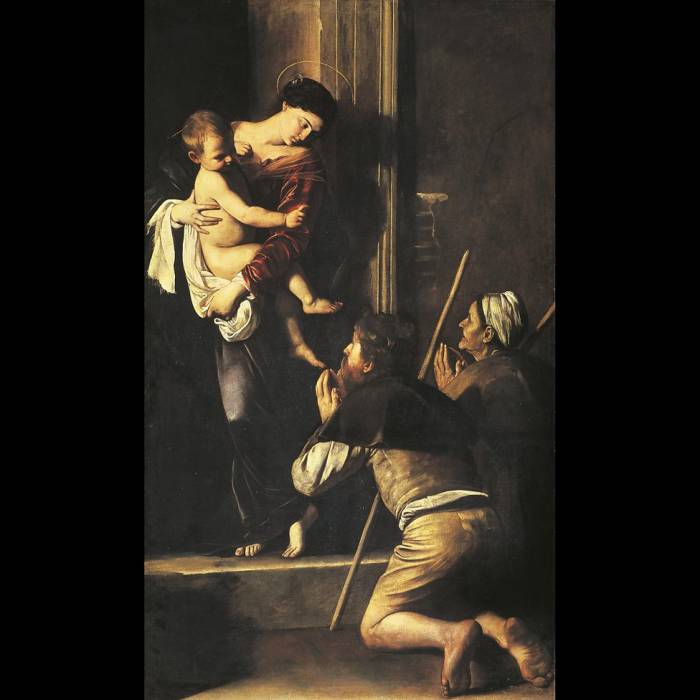
Italy, 1604-1605 | Getty Images
"Michelangelo Merisi da Caravaggio was a sinner, perhaps a double murderer, and a promiscuous bisexual. Hair-trigger violent, a foul-mouthed, unwashed hoodlum; constantly in trouble with the cops and in and out of jail. But if he acted like a devil he painted like an angel.
"Caravaggio knows this body well; it's likely to be his girlfriend. So his adoration of the Virgin dwells on her sumptuous form, the heavy lids, the glossy ropes of hair and that Child-Saviour could not be less spiritual; he's a bonny bambino overfed on milk and pasta.
"Beneath them kneel the pilgrims; a Darby and Joan whose long walk to Loreto is signalled on their calloused feet - the kind of detail on which Caravaggio, the virtuoso of our bodies, loved to linger. As in all the greatest Caravaggios, these big fleshy figures are uncomfortably, almost disturbingly close to us.
"Caravaggio has broken right through the fourth wall and he has done it in the name of making the Christian message true, by which he means physically true. We don’t get a kind of remote, heavenly apparition that’s granted to us by the intercession of some priest. No, we are physically in the company of the Madonna and child just as much as if we are walking down a street and look round and there they are, standing in a doorway.
"And this of course is a breach in every kind of decorum, social as well as aesthetic."
Starry Night Over the Rhône - van Gogh
Vincent van Gogh painted this scene of Arles at night at a spot on the Rhône's bank only a couple of minutes' walk from his house on the Place Lamartine.
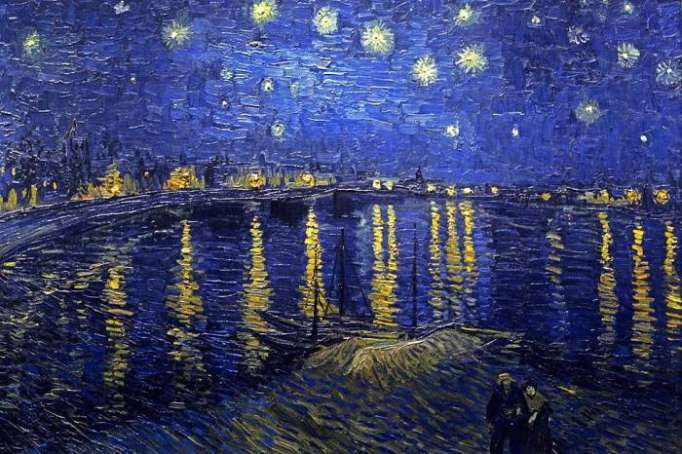
France, 1888 | Getty Images
"And so towards the end of his life, Vincent van Gogh gathered all the intensity of his emotional and spiritual longings into one defining obsession: how to bring heaven to earth and to turn it into a painting.
"So on a warm night in September 1888, he comes down from his little apartment and he sees this: the great expanse of the river Rhône, with the city of Arles reduced to a little rim of human activity and lit by rather sulphurous gas lights. And somehow this amazing moment speaks to him so that he can actually do this cosmic painting; and he creates a kind of compositional double trinity.
"The first trinity is of land, water and sky. The land is the little spit of the bank overlooking the Rhône with those very Japanese boats tied up in the harbour, and a couple of lovers staring out at us; then comes the river; and then comes the burning night sky delivered in great pulsing brushstrokes of heavily loaded aquamarine; and the three of them – land, water and sky – are all melting and dissolving together. It's an incredible psychological and emotional trip he’s on.
"And then the second trinity, more important even, is a trinity of illumination. The gas lamps are indicated by just a stab of crusty, dark yellow, slightly dirtied ochre; and then those gas lamps are reflected in the second element of the trinity of lights: the beautiful reflections which soften their harshness, and the third level of lights is Ursa Major exploding in the sky.
"He’s got this extraordinary sense of us in in the universe – and this couple – this little couple of lovers are staring out, feeling what he wants us to feel; ‘You don’t need to go to Church. The church today is this, this great illumination, like a burst of beauty from a stained glass window’. This is the radiance of here and now.
"Van Gogh didn’t live to see his rapture on canvas become the new church of colour for untold millions; his own mind skidded into darkness and self-destruction."
BBC
More about: ART








